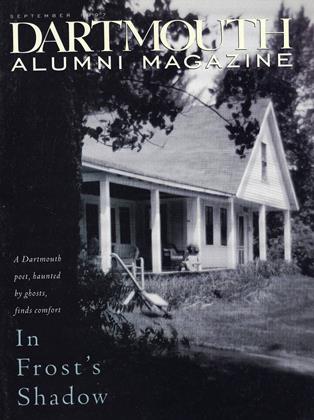An unprecedented exhibit at the Hood explores gender roles and the family in eighteenth-century France, and raises some contemporary questions.
SHOULD WOMEN STAY AT HOME with their children? Is it the government's responsibility to address the problem of "dead-beat dads"? Was the "coming out" episode of Ellen a primetime moral victory, or a national disgrace? As a society, we struggle to define gender roles, wrestle with state involvement in our families, and perceive popular culture as a powerful tool for social and moral
guidance. The very same topics were debated more than 200 years ago in France, and you can see the issues played out on canvas in a new exhibition at the Hood Museum of Art: "Intimate Encounters: Love and Domesticity in Eighteenth-Century France." Open from October 4, 1997 through January 4, 1998, this is the first major exhibition devoted solely to eighteenth-century French genre images. Curator Richard Rand and assistant Juliette Bianco '94 have assembled the works from North American and European collections, including the Hood's first loan from the Louvre.
In the early 1700s, France's influential Royal Academy of Painting and Sculpture reserved its highest accolades for historical painting. Dra- matic figures from classical and Biblical history presented the public with characters the Academy deemed appropriate to morally instruct and inspire. Meanwhile, genre paintings a "pop culture" equivalent which portrayed scenes from everyday life were beginning to depict the human figure in a different way. Often beautifully rendered, the images showed men and women of the aristocracy engaged in frivolous, sometimes erotic, pursuits; decorative and playful allegories of romantic love, full of the tension and role-playing of courtship. "The Academy considered these works to be morally inferior, and therefore discouraged them," says Rand.
Despite attacks from critics and academicians, genre paintings remained popular with collectors, and gradually, genre painters vied for official favor. They began to illustrate the social ideals espoused by rising Enlightenment reformers such as Rousseau and Diderot, depicting idealized images of the family, regardless of class. "No one in the eighteenth century would see these scenes as simply mirrors of reality," Rand states In keeping with Enlightenment philosophy, the genre painters captured the grace of domestic serenity, the order of gender-specific activities, and the strength of conjugal love. In Saying Grace, for example, the mother's lace is lit as if from a heavenly source, as she directs a keenly nurturing and loving gaze toward her young son. In Portrait of the Devil Family the child is placed mloving security between his mother and father, clutching his windmill toy in one hand while reaching for sweets with the other. These are images of love as the force that binds the social contract between two people, as in turn, each family was expected to bind the nation as a whole.
By the end of the century the old social contract had come undone wrenched apart by the French Revolution. The philosophical and moral debates raised in paint during the preceding century were settled by the guillotine. In 1793 even the influential Royal Academy of Painting and Sculpture was dismantled. When it re-opened after the revolution, there were few rules, and any painter could join
Beautiful and allegorical, this exhibition's images reveal a nation on the cusp of dramatic change. They address familiar and important issues which remain provocative, persistent, and elusive for society to resolve.
Saying Grace Jean-Simeon Chardin c. 1740-42 Musee du Louvre, Paris
just as modern viewers can identify a "soccer mom" at a glance, so eighteenthcentury viewers would instantly recognize a modest middle-class household filled with good moral behavior. In this painting, the radiant light on the mother's face contrasts with the sombre palette of the background, imbuing domestic ritual with spiritual reverence.
Portrait of the Devin Family
Louis-Michel Van Loo 1767 Los Angeles County Museum of Art
Jean-Jacques Julien and his demure Comtesse are the model for "family values." The briefcase marks Dad as a responsible member of the professional class. Since society proscribed women from idleness and intellectual audacity, Mom's needlepoint affirms her office. The richly-dressed child is the emotional link between the divergent roles of his parents.
Blindman's Buff
Jean-Honore Fragonard c. 1753-56 Toledo Museum of Art
This lush, aristocratic fantasy of a saucy milkmaid and a faux shepherd suggests the sort of fun a gal in a tight-fitting red dress might find in the abandon of the out-of- doors. Eighteenth- century viewers would immediately grasp the sexual symbolism of the rope and the bucket.
Christine Altieri coordinates art and production for this magazine.
 View Full Issue
View Full Issue
More From This Issue
-
 Cover Story
Cover StoryIn Frost's Shadow
September 1997 By CLEOPATRA MATHIS -
 Feature
FeatureThe Tightrope
September 1997 By Dan Fagin '85 -
 Feature
FeatureUninight
September 1997 By DOUGALD MACDONALD '82 -
 Article
ArticleRoad Trip
September 1997 By Sarah Moore -
 Article
ArticleElevator Going Up, AstroTurf Going Down
September 1997 By "E. Wheelock." -
 Article
ArticleEnvironmental Impact
September 1997 By Noel Perrin
Features
-
 Cover Story
Cover StoryLawrence Barcella '67
March 1993 -
 Feature
FeatureLEARN AMERICAN
June 1956 By EDWARD C. KIRKLAND '16 -
 Cover Story
Cover StoryHOW TO THROW A REALLY BIG SHOW
Sept/Oct 2001 By ERIC MARTIN '75 -
 Feature
FeatureCan Students Police Themselves?
SEPTEMBER | OCTOBER 2014 By EVA XIAO ’14 -
 Feature
FeatureThe Man Who Invented the Ant Farm (Not to Mention the Ant Coal Mine)
December 1988 By Lee Michaelides -
 Cover Story
Cover Story"Are the fireflies ghosts?"
OCTOBER 1985 By Priscilla Sears




